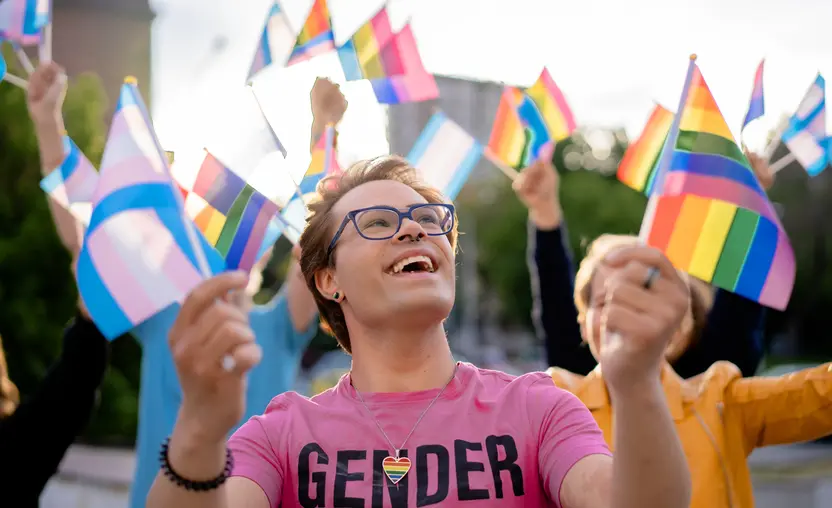A year-round guide to pride

Throughout June, individuals around the globe gather to honor Pride Month in the form of festivals, parties, and parades. However, amidst the myriad of celebrations and rainbow-clad attire, it’s easy to forget where Pride Month came from and how we got to where we are today.
Pride is both a celebration and a protest—it always has been. We celebrate to honor the monumental strides that have been made by the LGBTQ+ community towards safety and equality. We protest to fight the continued oppression and violence LGBTQ+ communities still endure today. And these efforts should never end when June does. For the queer community, their fight for equality, justice, and visibility never stops, and neither should allyship. In that spirit, we’ve compiled a year-round guide to Pride, complete with educational materials, allyship resources, and ways to give back during June and beyond. Whether you’re an individual or an organization looking to rally your workforce, there are ways for everyone to get involved!
A brief history
To better understand the importance of celebrating Pride in a meaningful way, let’s delve into a brief history of where Pride started and how it exists today.
Pride began in New York City in June 1969 when NYPD raided a known gay bar—The Stonewall Inn. These raids weren’t uncommon, but this raid specifically prompted LGBTQ+ patrons and residents to retaliate in the form of riots to confront the blatant homophobia demonstrated by the police. A year later, to expand on the growing resistance, protestors marched to Central Park in what was known as the first “gay pride.” Pride Month commemorates those who rebelled against the unjust systems of oppression and continues their fight toward acceptance, equality, and safety for LGBTQ+ communities.
Today, Pride Month has become a heavily commodified affair. From rainbow storefronts to “Pride collections” at clothing retailers, it’s easy to forget the origin of Pride and what it stands for. So, what’s wrong with all the rainbow-ness? In short, nothing. Sporting the rainbow can be a great way to recognize diversity, inclusion, and belonging (and also express yourself!). But ask yourself, what else are you doing to support the LGBTQ+ community? How will you commemorate the Stonewall riots? How will you honor those who risked their lives fighting for equality? Take this into consideration when celebrating this June.
Educational resources
Beyond learning about the history of Pride Month itself, June is a great opportunity to explore books, movies, music, and other forms of media developed by queer creators or centered on LGBTQ+ stories. Media representation is a powerful tool for shaping cultural understanding and provoking dialogue that leads to societal change. As a result, consuming queer media can be a great way to both support LGBTQ+ creators and better understand their histories, experiences, and identities.
Don’t know where to start when it comes to queer media? We’ve taken the guesswork out! Here are a few ideas for books, movies, music, and more to get you started!
Books: Celebrate Pride with LGBTQ+ stories! From inspirational memoirs to beautiful romances, these books honor the journeys of LGBTQ+ individuals and the larger struggle for love, acceptance, and equality. Check out the list from Goodreads!
Movies and television: Historically, LGBTQ+ movies and shows have been a rarity, especially ones that accurately portray queer characters. And while we’re a long way from total inclusivity and queer movies sans stereotypes, the film industry has made some recent strides in centering LGBTQ+ characters and prioritizing stories told by queer writers and directors. Check out this list of LGBTQ+ content hubs and some suggestions to get you started.
- Netflix recommendations: The Fear Street Trilogy, Disclosure, Vita & Virginia, Schitt’s Creek, Sex Education, and Heartstopper.
- Hulu recommendations: Booksmart, Moonlight, Portrait of a Lady on Fire, Pose, and Love, Victor.
- HBO Max recommendations: Shiva Baby, Paris is Burning, Pariah, Genera+ion, Sex Lives of College Girls, and Betty.
Audio: Beyond books and movies, the audio space has increasingly become a platform for LGBTQ+ creatives to have their voices heard and spotlight untold stories. Whether it’s in the form of music or podcasts, this can be a powerful source for LGBTQ+ storytelling, solidarity, and inspiration. To explore queer activists and creators within the audio landscape, check out Spotify’s Raise Your Voice content hub.
Being an ally
An ally is a person who supports, uplifts, and stands up for the equality of a marginalized or mistreated group they are not directly a part of. Being an ally takes work and requires consistent action. Step up your allyship this Pride and beyond with these five tips to being a better ally:
1. Understand your privilege
Identifying your own privilege does not mean things have always been easy for you, or that you have not had to overcome difficult circumstances. Instead, it just means there are some things in life that you will not experience or ever even have to think about because of some aspect of what makes you, you. By recognizing your privilege, you can better amplify the powerful voices of those you support.
2. Do your research
Spend time learning more about the history, struggles, accomplishments, stories, and current issues of the communities you want to support. There are a variety of ways you can do this—read books and online articles, watch documentaries, listen to podcasts and interviews, and follow people influential to the community to ensure you’re up to date on the important topics. Get started with the great list mentioned earlier in this article! And remember, it is not the responsibility of the oppressed to teach you what you don’t know. However, some friends and family members in these groups may be willing to have these conversations—be sure to ask if they are comfortable talking about these personal topics and be an active listener.
3. Speak up, show up, and listen
Speak up by using your privilege and voice to educate others in a way that does not speak over marginalized peoples or take credit for their ideas. If you hear someone say something hateful or ignorant, call them out—silence allows oppression to persist. In addition, show up to events, protests, and volunteer opportunities to listen, learn, and show your support. Be sure to do this year-round and not just during Pride. Most importantly, listen to what the marginalized communities you support are saying. Being an ally is an important role, but remember, it’s a supportive role. So be sure you are listening to and hearing the people you want to uplift.
4. Accept feedback and be aware of implicit biases
No one is perfect; unlearning bias and problematic precepts are part of the journey. You’re bound to mess up here and there, but that’s okay! It’s not about your intent—it’s about how you respond moving forward. If you make a mistake, listen, apologize, commit to correcting your mishaps, and keep moving along your journey of allyship. But don’t wait to be corrected. Instead, lean in and confront your own prejudices and bias, even when it’s uncomfortable. Continue to educate yourself and listen to those conversations around you, then put in the work to reverse any ingrained implicit biases that continue to exist today.
5. Get involved and stay engaged
Being an ally is ongoing. There are so many ways to become and stay involved in supporting and uplifting the marginalized communities you support. Donate, volunteer, or join a community nonprofit that supports the people you want to help; attend events and protests and vote in your local elections; spend time immersing yourself in resources and new experiences and always keep learning. Find even more ways to be an ally at the following resources: 5 Tips For Being An Ally, Guide to Allyship, How to be an Ally During Pride.
The world is a better place when we work together to support and empower one another. How can you be a better ally today?
Take action
Now that you’re armed with knowledge, it’s time to get to work! There are numerous ways to take action this month and all year long. Here we cover a few options to help you get started.
Donate
So many amazing organizations support and provide services to LBGTQ+ communities. They are doing incredible work to help educate, advocate, and support LGBTQ+ communities and their friends, families, allies, legislature, and beyond. Here we highlight just a few for you to check out, and then make your way over to their websites to see how you can get involved, donate, and learn more!
Casa Ruby
Casa Ruby is Washington DC’s only LGBTQ multicultural center. Casa Ruby provides social services and programs catering to the most vulnerable population, Transgender Women and Immigrants of Color. The idea behind the formation of a Trans Women of Color ran and led organization came almost 30 years ago when Ruby Corado arrived in DC as a young asylum seeker from El Salvador. Her drive and dream were to bring resources to historically underserved and under-resourced communities in order to create more success stories for transgender and queer folks.
Equality Texas
Equality Texas works to secure full equality for lesbian, gay, bisexual, transgender, and queer Texans through political action, education, community organizing, and collaboration. EQTX’s sibling organization, the Equality Texas Foundation, works to secure full equality for lesbian, gay, bisexual, transgender, and queer Texans through education, community organizing, and collaboration. EQTX envisions a Texas where lesbian, gay, bisexual, transgender, and queer Texans and their families have full equality in the hearts and minds of our fellow Texans and in all areas of the law.
Equitas Health
Equitas Health is a regional nonprofit community healthcare system and federally-designated Community Health Center. Established in 1984, it is now one of the largest LGBTQ+ and HIV/AIDS serving healthcare organizations in the United States. With 21 offices in 13 cities, Equitas Health serves tens of thousands of patients in Ohio, Kentucky, and West Virginia each year through patient-centered, integrated, and cutting edge services, including medical care, pharmacy, mental health and recovery, treatment and prevention, advocacy, and other community health initiatives.
National Center for Transgender Equality
The National Center for Transgender Equality advocates to change policies and society to increase understanding and acceptance of transgender people. In the nation’s capital and throughout the country, NCTE works to replace disrespect, discrimination, and violence with empathy, opportunity, and justice. Founded in 2003, NCTE envisions a society in which transgender people not only survive but thrive, with accepting families and communities, full self-determination over their identities and bodies, and freedom from disrespect, discrimination and violence. For this vision to become a reality, we must also create equity, equal opportunity, safety, health, and economic well-being for all people over their entire lifetimes.
Oakland LGBTQ Community Center
The Oakland LGBTQ Community Center is dedicated to enhancing and sustaining the well-being of lesbian, gay, bisexual, transgender, and queer (LGBTQ) individuals, their families and allies by providing educational, social, and health-related activities, programs and services. The Center offers case management, information and referral services, and a variety of health and wellness-related workshops, forums, peer support groups and community strengthening activities. The Center is also committed to supporting youth by providing several services, including support groups, workshops, employment opportunities and job training, food pantry services, transportation assistance and emergency housing services.
The Black Feminist Project
The Black Feminist Project enriches the lives of and restores agency, justice, joy, and health to Black Womxn, girls, and non-men often referred to as marginalized genders or MaGes and the children they care for—with an emphasis on mother-led families. Using dynamic and engaging food and reproductive justice programming that explores not only the intersections of race, class, gender, and respectability politics but also empowers them to tap into their inherent leadership abilities and dare to put themselves at the center of their own universes.
Celebrating Pride as an organization
While there are dozens of ways for individuals, groups, and communities to get involved in Pride Month celebrations, rallying your workforce can also be a powerful tool! However, before diving into your corporate social responsibility (CSR) planning, ensure you’re doing so with purpose, inclusion, and intention. To help, we’ve developed a list of key considerations for implementing a meaningful CSR Pride campaign to avoid these common pitfalls. Check it out!
1. Let the community speak
Before kickstarting your planning process, it’s crucial to get your workforce involved. Employees are more inclined to participate in your DEIB initiative if they have a say in making it happen. An easy way to gauge what your employees want is to send a survey asking how they’d like to honor Pride Month. Provide some suggestions or inspiration, but make sure you offer your workforce the space to present their own ideas.
And ensure you include LGBTQ+ individuals in the planning process! While you don’t want to assume that your queer employees want to spend the month educating the rest of your organization, it’s crucial to offer them the opportunity to provide input and get involved. Your organization should provide the support, resources, and leadership buy-in for these events, but it’s crucial they are led by LGBTQ+ individuals.
2. Take action
To ensure your corporate Pride initiative is more than just a rainbow-hued marketing campaign, put your money where your mouth is and take action. From monetary donations for LGBTQ+ nonprofits to volunteer time-off (VTO), there are a plethora of ways to encourage your employees to give back in meaningful ways! Here are a few ideas to get you started:
- Partner with LGBTQ+ nonprofits and feature them on your CSR platform to increase exposure.
- Offer an employee matching program to double the impact of their donations.
- Host a company-wide volunteer day at a local LGBTQ+ nonprofit or offer VTO so your workforce can give back in their own way.
- Host an event to fundraise for LGBTQ+ organizations.
- Ensure your workplace has equal rights protections for its employees.
- Invest in quality DEIB and LGBTQ+ educational training.
- Integrate DEIB initiatives into your culture, values, etc.
- Learn about and avoid rainbow-washing.
3. Go beyond June
Initiating programs that give back to the LGBTQ+ community during June is a great starting point! But your support for them shouldn’t stop there. Pride Month is simply a jumping-off point, and supporting LGBTQ+ communities requires a long-term investment and a year-round strategy. Here are some simple ways to go beyond June:
- Interrogate biases. Examine your processes for hiring, feedback, performance ratings, promotions, etc., and how they affect marginalized groups at your company. Even something as simple as a dress code likely has gendered underpinnings, which can be especially toxic for gender non-conforming and trans individuals.
- Reassess company benefits. Does your organization offer a comprehensive and inclusive benefits package? If your insurance plan doesn’t cover queer and trans-related healthcare, then it might be time to reassess.
- Enable recurring giving. Partner with LGBTQ+ nonprofits year-round! And don’t just limit your organization to national NPOs. Allocate funds to smaller and more localized organizations within your own community.
- Leverage employee resource groups. If your company doesn’t already have an employee resource group (ERG) for LGBTQ+ individuals, provide the support, resources, and tools needed to implement one. Creating safe, anonymous spaces for queer employees is crucial to cultivating an inclusive culture.
- Support queer creators. Company swag is popular amongst many organizations, especially during the holidays. This year, support the LGBTQ+ community by finding a queer creator who can print your swag or come up with a design.
A year-round commitment
When June ends and Pride makes way for the next community to recognize, support, and celebrate, remember your work to uplift and advocate for LGBTQ+ communities isn’t done. So, save these resources, tips, and considerations and apply them to your everyday giving and advocacy efforts. Whether it’s calling out a queer-phobic joke or attending a local protest against anti-LGBTQ+ legislation, any action can and will make a difference.
This Pride Month, dress up in your rainbow-clad attire but don’t let your celebrations stop there! Take time for learning, advocacy, and giving throughout June and year-round.
Happy Pride!
Ready to Get Started?
Work with Bonterra



